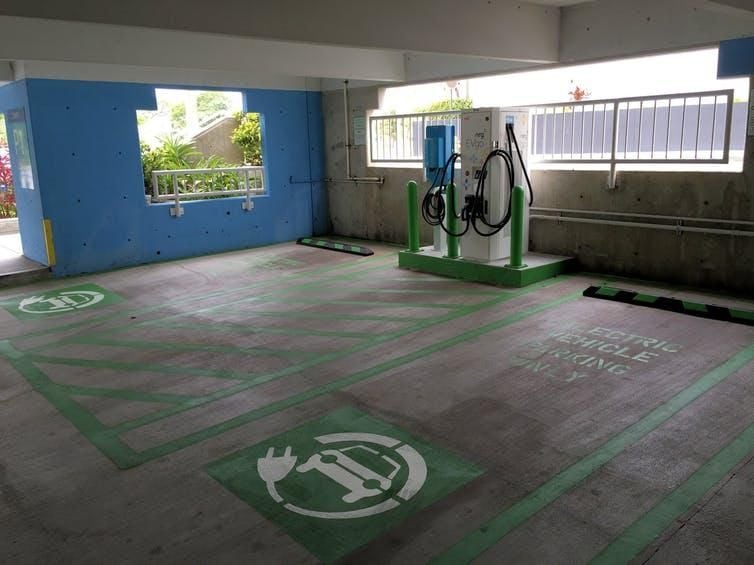For Electric Vehicles to Take Off, Apartments Need to Come with Charging Stations
As EVs make more inroads, giving tenants somewhere to plug in their cars could become a selling point
/https://tf-cmsv2-smithsonianmag-media.s3.amazonaws.com/filer/03/44/034444a9-07c0-45da-9eb0-05a68c2a789d/file-20180726-106496-1tlnlkq.jpg)
Americans have now purchased more than 800,000 electric vehicles, counting both plug-in hybrids and all-electric models. That may sound like a lot of EVs, and it is a big jump from the less than 5,000 that were on the road in 2010. But this is still less than 1 percent of all U.S. registered vehicles, despite the recent availability of longer-range, more affordable EV models like the Chevrolet Bolt.
Policymakers nonetheless see EVs as having great potential to reduce carbon dioxide emissions and other forms of pollution, and are supporting tax credits and other policies to encourage people to buy EVs. California, for example, aims to have 5 million of them on its roads by 2030.
But to meet ambitious goals like that, EVs will need to stop being a niche product and appeal to as many drivers as possible.
I am an energy economist working on transportation policy, and I’ve looked at newly available data to try to understand why people purchase EVs. It turns out that renting a home may be one of the biggest barriers.
A striking difference
New federal data show that homeowners are more than three times more likely than renters to own an EV. And since 43 million U.S. households – 37 percent of all households – rent their homes, it is worth thinking hard about why this gap exists.
By analyzing the Transportation Department’s newly released 2017 National Household Travel Survey data, I found striking differences in EV ownership between homeowners and renters. In California, homeowners are three times more likely to own an EV than renters.
The gap is even wider for the rest of the U.S., where homeowners are six times more likely to own an EV than renters.
Income isn’t everything
You might be thinking that this gap is caused by income. It is true that EV ownership is higher for richer people, which is only natural since EVs cost more to buy than comparable gasoline-powered vehicles although charging them is cheaper than filling a tank.
But I learned that homeowners are more likely than renters to own EVs, even when they have similar income levels. For example, among households earning between US$75,000 and $100,000 per year, 1 in 130 homeowners owns an EV, compared to 1 in 370 renters.
Parking and charging
The other big difference between homeowners and renters is having a place to park.
Most homeowners have a garage, a driveway or both. That makes charging extremely convenient for them because they can charge their vehicles at night.
It’s not so easy, however, for many renters. Renters are more likely to live in multi-unit buildings and parking spots may not be assigned, or there may not be any parking spots at all. The federal data doesn’t provide any information about parking availability, but this likely helps explain the disparity between homeowners and renter EV ownership rates.
There is also the related question of charging equipment.
For homeowners, it is relatively straightforward to invest in a 240-volt outlet, electric panel upgrades and other improvements to speed up charging. These investments can cost $1,000 or more, but are a good investment for a homeowner planning to stay put.
Making this investment is trickier for renters, however. They may not want to invest their own money in a property they don’t own and their landlords may be unwilling to let them do it in any case due to liability and other concerns.
This quandary is what economists call a landlord-tenant problem. In theory, a landlord could make investments like this, and then charge higher rent to recoup the cost. In practice, however, this can get complicated.
Even if the current tenant has an EV – the next tenant may not. And if future tenants don’t have EVs then they won’t need – or appreciate – having charging equipment handy. Several studies, including work by economist Erica Myers, show that renters tend not to value the energy-related investments their landlords make.

Public support for charging
California policymakers are well aware of these challenges and that is a big reason why they are investing heavily in charging stations. The state is spending $2.5 billion to bring 250,000 charging stations statewide by 2025. Each of these stations will support several EVs, so this will make charging much easier for EV owners.
Much of this funding will cover the cost of building charging stations in communities with a lot of renters. The big utility Pacific Gas & Electric, for example, is making multifamily residences a high priority as it builds thousands of new charging stations across the state. As this charging infrastructure grows, the EV market is bound to expand as well.
I’m eager to see whether these investments will narrow the homeowner-renter gap.
While writing this article, I searched on the Zillow real estate website for rental listings in San Francisco and could find only four apartments that mentioned EV charging as an amenity.
This isn’t many compared to the more than 1,000 of the apartments on the market, but I have no doubt that there will be many more landlords giving their tenants a place to plug in their cars as more renters buy EVs in the near future.
This article was originally published on The Conversation.
Lucas Davis, Professor at the Haas School of Business, University of California, Berkeley